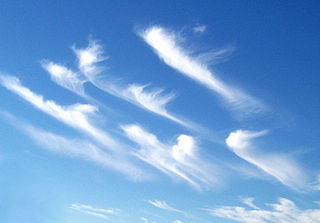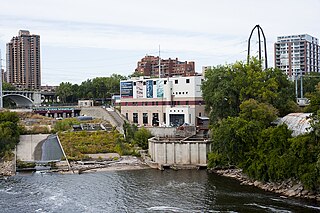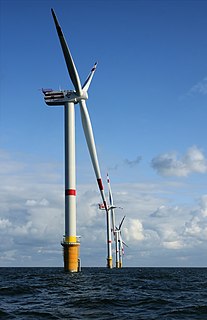
Wind tunnels are large tubes with air blowing through them which are used to replicate the interaction between air and an object flying through the air or moving along the ground. Researchers use wind tunnels to learn more about how an aircraft will fly. NASA uses wind tunnels to test scale models of aircraft and spacecraft. Some wind tunnels are large enough to contain full-size versions of vehicles. The wind tunnel moves air around an object, making it seem as if the object is flying.

Ocean Thermal Energy Conversion (OTEC) uses the ocean thermal gradient between cooler deep and warmer shallow or surface seawaters to run a heat engine and produce useful work, usually in the form of electricity. OTEC can operate with a very high capacity factor and so can operate in base load mode.

Wind shear, sometimes referred to as wind gradient, is a difference in wind speed or direction over a relatively short distance in the atmosphere. Atmospheric wind shear is normally described as either vertical or horizontal wind shear. Vertical wind shear is a change in wind speed or direction with a change in altitude. Horizontal wind shear is a change in wind speed with a change in lateral position for a given altitude.

In meteorology, a downburst is a strong ground-level wind system that emanates from a point source above and blows radially, that is, in straight lines in all directions from the point of contact at ground level. Often producing damaging winds, it may be confused with a tornado, where high-velocity winds circle a central area, and air moves inward and upward; by contrast, in a downburst, winds are directed downward and then outward from the surface landing point.

The concept of a vortex engine or atmospheric vortex engine (AVE), independently proposed by Norman Louat and Louis M. Michaud, aims to replace large physical chimneys with a vortex of air created by a shorter, less-expensive structure. The AVE induces ground-level vorticity, resulting in a vortex similar to a naturally occurring landspout or waterspout.

The National Wind Institute (NWI) at Texas Tech University (TTU) was established in December 2012, and is intended to serve as Texas Tech University’s intellectual hub for interdisciplinary and transdisciplinary research, commercialization and education related to wind science, wind energy, wind engineering and wind hazard mitigation and serves faculty affiliates, students, and external partners.
Wind engineering is a subset of mechanical engineering, structural engineering, meteorology, and applied physics that analyzes the effects of wind in the natural and the built environment and studies the possible damage, inconvenience or benefits which may result from wind. In the field of engineering it includes strong winds, which may cause discomfort, as well as extreme winds, such as in a tornado, hurricane or heavy storm, which may cause widespread destruction. In the fields of wind energy and air pollution it also includes low and moderate winds as these are relevant to electricity production and dispersion of contaminants.

Severe weather is any dangerous meteorological phenomenon with the potential to cause damage, serious social disruption, or loss of human life. Types of severe weather phenomena vary, depending on the latitude, altitude, topography, and atmospheric conditions. High winds, hail, excessive precipitation, and wildfires are forms and effects of severe weather, as are thunderstorms, downbursts, tornadoes, waterspouts, tropical cyclones, and extratropical cyclones. Regional and seasonal severe weather phenomena include blizzards (snowstorms), ice storms, and duststorms.

Atmospheric convection is the result of a parcel-environment instability, or temperature difference layer in the atmosphere. Different lapse rates within dry and moist air masses lead to instability. Mixing of air during the day which expands the height of the planetary boundary layer leads to increased winds, cumulus cloud development, and decreased surface dew points. Moist convection leads to thunderstorm development, which is often responsible for severe weather throughout the world. Special threats from thunderstorms include hail, downbursts, and tornadoes.
Specialized wind energy software applications aid in the development and operation of wind farms.

The Saint Anthony Falls Laboratory, or SAFL, is a research laboratory situated on Hennepin Island in the Mississippi River in Minneapolis, Minnesota, United States. Its primary research is in "Engineering, Environmental, Biological, and Geophysical Fluid Mechanics". It is affiliated with the University of Minnesota's College of Science and Engineering. Research is conducted by graduate students and faculty alike using the 16,000 square feet of research space and 24 different specialized facilities.
Wind resource assessment is the process by which wind power developers estimate the future energy production of a wind farm. Accurate wind resource assessments are crucial to the successful development of wind farms.

A wind turbine is a device that converts the wind's kinetic energy into electrical energy.
Flow conditioning ensures that the “real world” environment closely resembles the “laboratory” environment for proper performance of inferential flowmeters like orifice, turbine, coriolis, ultrasonic etc.
The following is a glossary of tornado terms. It includes scientific as well as selected informal terminology.

The R. J. Mitchell Wind Tunnel is a low-speed wind tunnel which is part of the Faculty of Engineering and the Environment at the University of Southampton. It is the largest wind tunnel in University ownership in the UK. It is named after famed British aircraft designer R.J. Mitchell.

Joseph Katz is an Israel-born American fluid dynamicist, known for his work on experimental fluid mechanics, cavitation phenomena and multiphase flow, turbulence, turbomachinery flows and oceanography flows, flow-induced vibrations and noise, and development of optical flow diagnostics techniques, including Particle Image Velocimetry (PIV) and Holographic Particle Image Velocimetry (HPIV). As of 2005, he is the William F. Ward Sr. Distinguished Professor at the Department of Mechanical Engineering of the Whiting School of Engineering at the Johns Hopkins University.

A vertical-axis wind turbine (VAWT) is a type of wind turbine where the main rotor shaft is set transverse to the wind while the main components are located at the base of the turbine. This arrangement allows the generator and gearbox to be located close to the ground, facilitating service and repair. VAWTs do not need to be pointed into the wind, which removes the need for wind-sensing and orientation mechanisms. Major drawbacks for the early designs included the significant torque variation or "ripple" during each revolution, and the large bending moments on the blades. Later designs addressed the torque ripple issue by sweeping the blades helically. Savonius vertical-axis wind turbines (VAWT) are not widespread, but their simplicity and better performance in disturbed flow-fields, compared to small horizontal-axis wind turbines (HAWT) make them a good alternative for distributed generation devices in urban environment.

The artificial sky is a daylight simulation device that replicates the light coming from the sky dome. An architectural scale model or 1:1 full-scaled aircraft is placed under an artificial sky to predict daylight penetration within buildings or aircraft that subjects to different situations, complex geometries, or heavily obstructed windows. The concept of the artificial sky was derived due to heliodon’s limitation in providing a stable lighting environment for evaluating the diffuse skylight component.
















